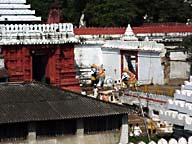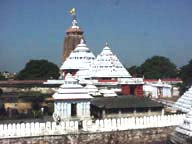| Jagannath Temple | ||
 Figure1 |
 Figure 2 |
 Figure 3 |
Introduction | Jagannath
| the Epics | Gods and Goddesses |
Folklore and Erotic Themes | References
Table of Contents
Pata-Chitras of
Orissa:
An Illustration of Some Common Themes
by Bernard Cesarone
May 16, 2001
click on small images for large images with captions
IntroductionThe state of Orissa in northeast India has a long tradition in various arts, including dance, architecture, and painting. Among the painting traditions, the devotional art of the pata-chitras,1 or paintings on cloth, is a folk or popular style that centers around the worship of the god Jagannath (or Jagannatha) but that depicts many other religious themes as well, using the strong line and brilliant color that are typical of Orissan folk painting. This article presents a collection of pata-chitras, organized around a series of general themes, in order to highlight various formats and particular thematic subjects used in the tradition. So that the paintings might be understood within a context, introductory information is provided on the god Jagannath, on the Jagannath temple in Puri and its rituals, and on pata-chitra painters and their work. Subsequent sections illustrate paintings related to the god Jagannath, scenes from the epic stories, pictures of deities, a picture with a folklore theme, and a picture with erotic overtones. Each section explains some of the details of the particular images, identifies some of the iconography used in the images, or recounts some stories related to those images. 1. The Jagannath triad Jagannath is a deity widely worshiped in Orissa (and elsewhere in India). The god's Sanskrit name means "Lord of the world" (from jagan, world, and natha, lord). However, some scholars have suggested that the word is a sanskritization of a tribal word 2 and have presented arguments related to the god's possible tribal origins.3 Nevertheless, by the devotees who come to see their Lord at the temple, he is typically identified with Krishna. The most famous of the god's many shrines is his temple in Puri. In this temple, Jagannath is not installed alone, but is part of a triad of deities that also includes his brother Balabhadra and his sister Subhadra. Of these, Balabhadra is identified with Balarama, the brother of Krishna, and Subhadra is said to be the goddess Bhubaneshwari. The iconography of the three deities will be discussed below. 2. The Jagannath temple in Puri Orissa is justly famous for its many beautiful temples. The classical period of Orissan temple building was from approximately the beginning of the eighth century to around the middle of the thirteenth century. Temples were constructed to various deities, but the temples to Jagannath in the towns and villages of Orissa are most relevant to the pata-chitra tradition. As mentioned above, the most famous of these is the temple to Jagannath in Puri, which is a seaside pilgrimage city on the Bay of Bengal. This temple was built in approximately 1135-1150 by Codaganga, a king of the Eastern Ganga dynasty.4 The temple became a great center of pilgrimage and, in recent centuries at least, pilgrims who came to the temple for a darshan (viewing) of the deity frequently purchased a pata-chitra painting as a memento of their visit or as a gift for friends or family back home. This practice continues today. Figures 1, 2, and 3 (below) present some views of the Jagannath temple at Puri at its principal eastern entrance or gateway, the so-called lion gate.
|
|
3. Chitrakaras The artists who paint pata-chitras are known as chitrakaras. Often, a whole family is engaged in the work of preparing pata-chitras, under the supervision of the master painter in the family. Sometimes, a master artist will operate a studio in which apprentices and other artists of varying levels of skill work under his direction. As the products of the chitrakaras' work are intended for a pilgrim audience, the chitrakaras typically live in the vicinities of temples, such as the Jagannath temple in Puri. Chitrakaras are also concentrated in the village of Raghurajpur, just outside Puri. Besides painting pata-chitras, the chitrakaras have other artistic duties, often related to the yearly cycle of festivals around the Jagannath temple. For example, chitrakaras paint anasara patis, which are paintings that temporarily replace the principal images of the three deities while those deities are considered "ill" and are unavailable for viewing by the faithful.5 The chitrakaras of Puri also have several painting duties on the cars, or chariots, on which Jagannath, Balabhadra, and Subhadra ride during the annual ratha yatra (car festival) each summer. In this festival, each of the three deities rides in a large chariot (Jagannath's is 45 feet high) from their home in the Jagannath temple, along Puri's wide Grand Road to the Gundica temple about three kilometers away, and then back again. Figure 4 shows a view of Grand Road, looking away from the Jagannath temple.6 Chitrakaras paint the walls of a small temple next to the Narendra reservoir during the chandana yatra (sandalwood festival), a festival during which images of Krishna, Lakshmi, and Sarasvati are rowed in boats in the reservoir. The painters also paint pedi, or dowry boxes, that are given to the bride at the time of marriage.7 An illustration of a painting on a dowry box is included below in the discussion of the kanchi avijana episode in the mythology of Jagannath. 4. Techniques of pata painting The process of producing pata-chitras has been documented elsewhere,8 and thus will be only briefly described here. The process begins with a sheet of cotton cloth being laid out on the ground. To this cloth is applied a coat of gum or glue made from tamarind seed. Then a second cloth is laid on top of this and another layer of tamarind glue is applied. The cloths are then left to dry in the sun. When the layered cloth is dry, it is cut to the desired sizes of finished pages and burnished on both sides, first with a coarse stone and finally with a smooth pebble. The design is sketched and the outlined areas of the sketch are filled in with primary colors, traditionally from vegetable or mineral pigments, but in recent years from store-bought colors also. Large areas of color are applied first and the details are then painted in these areas of solid color. When the painting is completed, it may be covered with a coat of lacquer. 5. Themes depicted in pata-chitras It is possible to categorize the themes of pata-chitras in various ways. But for the purposes of this article, we will follow the convenient system suggested by Mohanty (1984, p.9). He identifies the following themes:
Mohanty actually lists a sixth theme, that of animals and birds. However, these paintings will not be illustrated in this article. For the first of the themes, we will look at some examples of paintings that involve Jagannath and the other deities of the triad in their roles at the Puri temple, that show scenes from the mythology of Jagannath, and that provide a schematic diagram of the Puri temple. We will deviate a little bit from the focus on pata-chitras to show related wood carvings of the Puri triad. Next, episodes from two of the epics (or puranas), the Bhagavata Purana and the Ramayana, will be illustrated. Related to pata-chitras that portray puranic episodes is a more modern type of painting in which multiple scenes surround a central scene. The last section of the article will discuss pictures of various deities, the folklore theme of navagunjara, and the kandarpa ratha, a picture with erotic connotations. In pata-chitras on these various themes, the images depicted are often based on dhyanas (Mohanty, 1980, p.12). Sanskrit texts (puranas, tantras, and other texts) commonly contain passages describing a deity in a way that allows the god or goddess to be clearly imagined in meditation. Such a description is called a dhyana (meaning "meditation").9 A dhyana, for example, may be an image of Sarasvati standing with her vina in hand, or Krishna playing his flute while embracing Radha. Before proceeding to the illustrations of pata-chitras, let us note some common (but not necessarily universal) characteristics of the pata paintings that are presented. 10
Besides these common characteristics, there are also many typical iconographic details in pata-chitras, such as the following:
Figures are typically shown with a frontal view of the body but a profile view of the head. Figures do not usually overlap; that is, one character in a painting will not be shown in front of another. Sages are depicted with matted hair. Characters often wear jewelry. Noted personages wear crowns, such as the crown with the tilted plumes that Krishna wears and the crown with a mango-shaped (similar to paisley) crest worn by queens.11 Colors are applied flat within outlined areas of pata-chitras; that is, shading is not used. There is no attempt to convey a sense of volume to the figures. Perspective is absent and the chitrakaras do not strive for realism in their portrayal of people or the natural world. Continue to Part II: Themes Related to Jagannath Text and pictures ©
2001 by and Kalarte Gallery. |
|
Table of Contents
Introduction | Jagannath
| the Epics | Gods and Goddesses |
Folklore and Erotic Themes | References